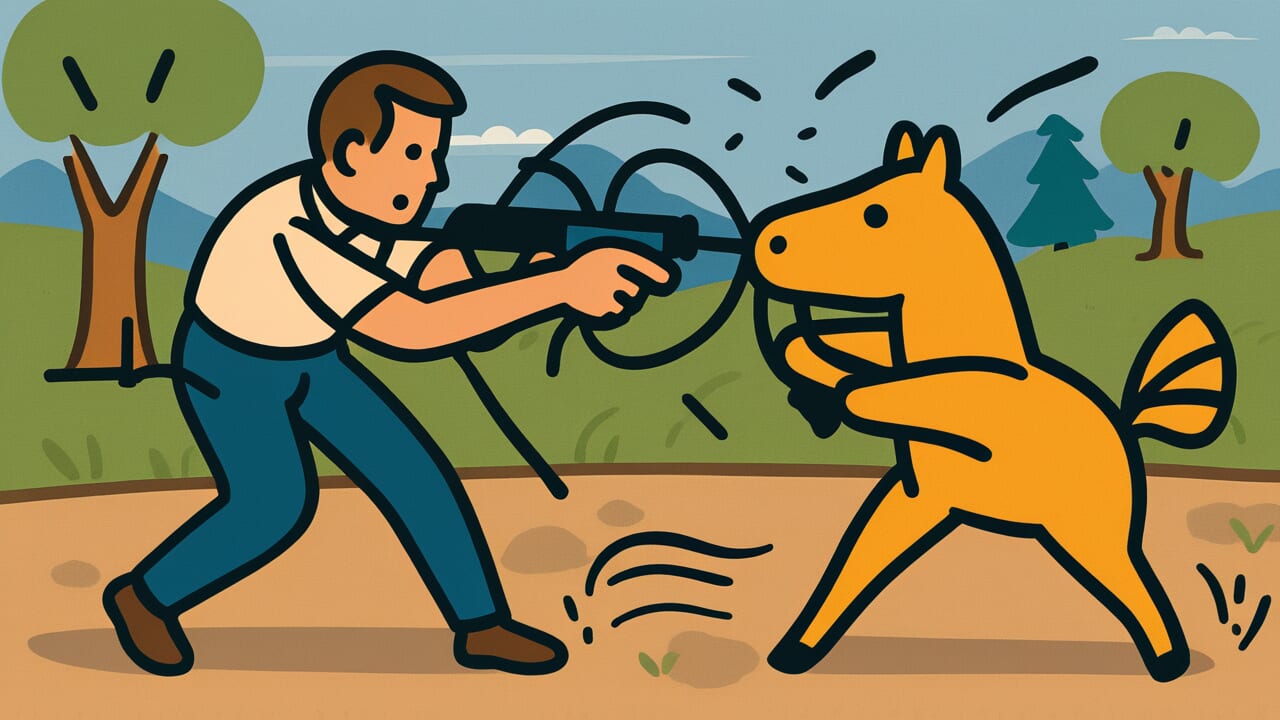How to Read “To kill a mosquito, don’t shoot its horse”
Ka wo korosu ni wa sono uma wo utazu
Meaning of “To kill a mosquito, don’t shoot its horse”
This proverb warns against using ridiculously excessive methods to solve small problems. You wouldn’t shoot a valuable horse just to kill a tiny mosquito on it.
The saying teaches us to balance our goals with our methods. The mosquito is insignificant, but the horse is precious.
People use this proverb when someone tries to overreact to minor issues. For example, spending huge amounts of money to fix a small inconvenience.
Or sacrificing something important just to correct a tiny mistake. The extreme imagery makes the point impossible to miss.
In modern times, this wisdom matters even more. We talk about efficiency and cost-effectiveness constantly.
When solving problems, we must choose responses that match the problem’s actual size. Not every issue deserves a nuclear option.
Origin and Etymology
No clear historical records explain exactly when this proverb first appeared. However, we can learn a lot from how the phrase is constructed.
The key is the extreme contrast between the small goal and the huge method. A mosquito is annoying but harmless.
You can swat it with your hand. A horse, on the other hand, was incredibly valuable in old Japan.
Horses provided labor and transportation. They were essential to daily life and survival. Shooting one would mean devastating financial loss.
The cleverness lies in the negative form: “don’t shoot.” The proverb doesn’t describe someone actually shooting the horse.
Instead, it warns against doing so. This makes it a teaching tool rather than a story.
Likely, someone observed people overreacting to trivial problems in daily life. They created this vivid comparison to make their point memorable.
The absurd image stuck in people’s minds. Over time, it became a standard saying passed down through generations.
Usage Examples
- Replacing your entire computer just to fix a virus? That’s like “to kill a mosquito, don’t shoot its horse.”
- Digging up your whole garden to remove a few weeds is “to kill a mosquito, don’t shoot its horse.”
Universal Wisdom
This proverb endures because it targets a fundamental human weakness. When facing problems, we often lose our cool and overreact.
Difficulties and discomfort trigger an urgent desire for quick solutions. This urgency clouds our judgment.
We stop seeing the true scale of the problem. A mosquito bite is a minor annoyance, nothing more.
But it can steal our ability to think clearly. The impulse becomes “I must fix this now, no matter what.”
Looking deeper, this reveals our perfectionist tendencies. Even small imperfections feel intolerable.
The desire to eliminate every flaw completely can lead us to sacrifice what truly matters. We lose perspective.
Our ancestors understood this human weakness well. That’s why they used such an extreme example as a warning.
The contrast between mosquito and horse forces us to pause and reflect. What really matters here?
What am I about to lose? Does this problem truly justify such a sacrifice?
These questions remain essential across all eras. This timeless wisdom helps us protect what we value most.
When AI Hears This
Swatting mosquitoes one by one versus moving the horse to a different location requires similar effort. But the results differ by a factor of 100.
This captures what systems thinking calls a “leverage point.” In system theory, intervention points exist in hierarchies.
The least effective intervention is “adjusting numbers” or parameter tweaking. Killing mosquitoes one by one falls into this category.
If you can kill one mosquito per minute, 100 mosquitoes take 100 minutes. Meanwhile, new mosquitoes keep arriving around the horse.
This is linear problem-solving. Your effort and results maintain a proportional relationship.
Moving the horse to a mosquito-free area, however, “changes the system structure.” One action eliminates the source of the problem entirely.
In manufacturing, increasing inspectors to catch defects is swatting mosquitoes. Redesigning the production process itself is moving the horse.
Toyota’s “Five Whys” method also seeks root causes (the horse’s location) rather than surface symptoms (the mosquitoes).
Interestingly, human brains naturally focus on concrete, immediate problems (mosquitoes). We easily miss abstract structures (the relationship between horse and environment).
Evolutionarily, responding to immediate threats helped survival. That’s why we must consciously train ourselves to see whole systems.
Lessons for Today
This proverb teaches modern people to stay calm when facing problems. Our daily lives overflow with small frustrations and inconveniences.
If we respond to each one with full force, we’ll have no energy left to protect what truly matters.
Modern society pushes us toward instant, perfect solutions. But not all problems carry equal weight.
Is the worry you’re facing right now really worth such a sacrifice? Take a moment to consider.
What matters most is developing the habit of pausing to think. What’s the real nature of this problem?
What level of response is actually appropriate? What should I be protecting here?
Cultivate the ability to answer these questions. Sometimes, accepting small inconveniences shows wisdom and maturity.
Pursuing perfection at the cost of losing something precious defeats the whole purpose. That’s putting the cart before the horse.
In your life, what represents the horse—the truly valuable thing? Maybe it’s your time. Maybe it’s your relationships.
Don’t let mosquito-sized problems control you. Protect what genuinely has value. That’s the mark of a wise person.



Comments